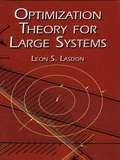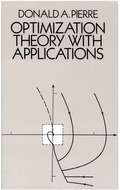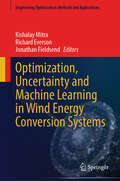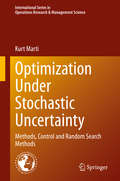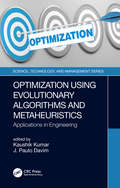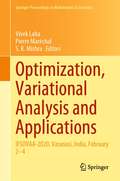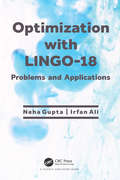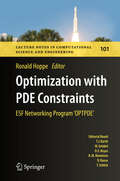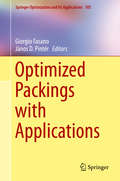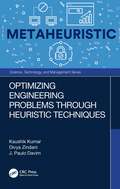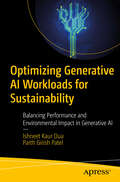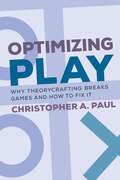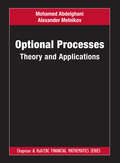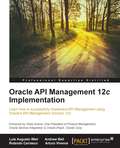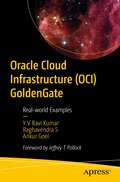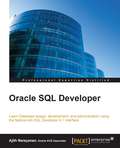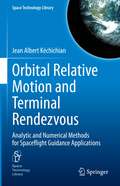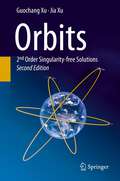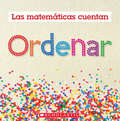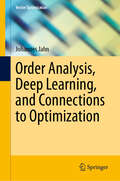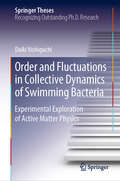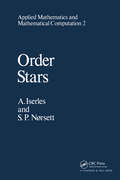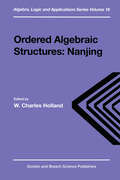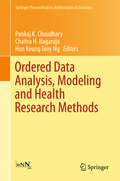- Table View
- List View
Optimization Theory for Large Systems (Dover Books on Mathematics)
by Leon S. LasdonImportant text examines most significant algorithms for optimizing large systems and clarifying relations between optimization procedures. Much data appear as charts and graphs and will be highly valuable to readers in selecting a method and estimating computer time and cost in problem-solving. Initial chapter on linear and nonlinear programming presents all necessary background for subjects covered in rest of book. Second chapter illustrates how large-scale mathematical programs arise from real-world problems. Appendixes. List of Symbols.
Optimization Theory with Applications
by Donald A. PierreOptimization principles are of undisputed importance in modern design and system operation. They can be used for many purposes: optimal design of systems, optimal operation of systems, determination of performance limitations of systems, or simply the solution of sets of equations. While most books on optimization are limited to essentially one approach, this volume offers a broad spectrum of approaches, with emphasis on basic techniques from both classical and modern work.After an introductory chapter introducing those system concepts that prevail throughout optimization problems of all types, the author discusses the classical theory of minima and maxima (Chapter 2). In Chapter 3, necessary and sufficient conditions for relative extrema of functionals are developed from the viewpoint of the Euler-Lagrange formalism of the calculus of variations. Chapter 4 is restricted to linear time-invariant systems for which significant results can be obtained via transform methods with a minimum of computational difficulty. In Chapter 5, emphasis is placed on applied problems which can be converted to a standard problem form for linear programming solutions, with the fundamentals of convex sets and simplex technique for solution given detailed attention. Chapter 6 examines search techniques and nonlinear programming. Chapter 7 covers Bellman's principle of optimality, and finally, Chapter 8 gives valuable insight into the maximum principle extension of the classical calculus of variations.Designed for use in a first course in optimization for advanced undergraduates, graduate students, practicing engineers, and systems designers, this carefully written text is accessible to anyone with a background in basic differential equation theory and matrix operations. To help students grasp the material, the book contains many detailed examples and problems, and also includes reference sections for additional reading.
Optimization, Uncertainty and Machine Learning in Wind Energy Conversion Systems (Engineering Optimization: Methods and Applications)
by Kishalay Mitra Richard Everson Jonathan FieldsendThis book presents state-of-the-art technologies in wind farm layout optimization and control to improve the current industry/research practice. The contents take readers towards a different kind of uncertainty handling through the discussion on several techniques enabling maximum energy harnessing out of uncertain situations. The book aims to give a detailed overview of such concepts in the first part, where the recent advancements in the fields of (i) Wind farm layout optimization, (ii) Multi-objective Optimization and Uncertainty handling in optimization methods, (iii) Development of Machine Learning-based surrogate models in optimization, and (iv) Different types of wake models for wind farms will be discussed. The second part will cover the application of the aforementioned techniques on the wind farm layout optimization and control through several chapters such as (i) Wind farm performance assessment using Computational Fluid Dynamics (CFD) tools, (ii) Artificial Neural Network (ANN) based hybrid wake models, (iii) Long Short-term Memory (LSTM) & Support Vector Regression (SVR) based forecasting and micro-siting, (iv) windfarm micro-siting using data-driven Robust Optimization (RO) as well as Generative Adversarial Networks (GANs), (v) Reinforcement learning (RL) based wind farm control and (vi) Application of eXplainable AI (XAI) tools for interpreting wind time-series data. In this manner, the book provides state-of-the-art techniques in the fields of multi-objective optimization, Evolutionary Algorithms, Machine Learning surrogate models, Bayesian Optimization, Data Analysis, and Optimization under Uncertainty and their applications in the field of wind energy generation that can be extremely generic and can be applied to many other engineering fields. This volume will be of interest to those in academia and industry.
Optimization Under Stochastic Uncertainty: Methods, Control and Random Search Methods (International Series in Operations Research & Management Science #296)
by Kurt MartiThis book examines application and methods to incorporating stochastic parameter variations into the optimization process to decrease expense in corrective measures. Basic types of deterministic substitute problems occurring mostly in practice involve i) minimization of the expected primary costs subject to expected recourse cost constraints (reliability constraints) and remaining deterministic constraints, e.g. box constraints, as well as ii) minimization of the expected total costs (costs of construction, design, recourse costs, etc.) subject to the remaining deterministic constraints.After an introduction into the theory of dynamic control systems with random parameters, the major control laws are described, as open-loop control, closed-loop, feedback control and open-loop feedback control, used for iterative construction of feedback controls. For approximate solution of optimization and control problems with random parameters and involving expected cost/loss-type objective, constraint functions, Taylor expansion procedures, and Homotopy methods are considered, Examples and applications to stochastic optimization of regulators are given. Moreover, for reliability-based analysis and optimal design problems, corresponding optimization-based limit state functions are constructed. Because of the complexity of concrete optimization/control problems and their lack of the mathematical regularity as required of Mathematical Programming (MP) techniques, other optimization techniques, like random search methods (RSM) became increasingly important.Basic results on the convergence and convergence rates of random search methods are presented. Moreover, for the improvement of the – sometimes very low – convergence rate of RSM, search methods based on optimal stochastic decision processes are presented. In order to improve the convergence behavior of RSM, the random search procedure is embedded into a stochastic decision process for an optimal control of the probability distributions of the search variates (mutation random variables).
Optimization Using Evolutionary Algorithms and Metaheuristics: Applications in Engineering (Science, Technology, and Management)
by Kaushik Kumar J. Paulo DavimMetaheuristic optimization is a higher-level procedure or heuristic designed to find, generate, or select a heuristic (partial search algorithm) that may provide a sufficiently good solution to an optimization problem, especially with incomplete or imperfect information or limited computation capacity. This is usually applied when two or more objectives are to be optimized simultaneously. This book is presented with two major objectives. Firstly, it features chapters by eminent researchers in the field providing the readers about the current status of the subject. Secondly, algorithm-based optimization or advanced optimization techniques, which are applied to mostly non-engineering problems, are applied to engineering problems. This book will also serve as an aid to both research and industry. Usage of these methodologies would enable the improvement in engineering and manufacturing technology and support an organization in this era of low product life cycle. Features: Covers the application of recent and new algorithms Focuses on the development aspects such as including surrogate modeling, parallelization, game theory, and hybridization Presents the advances of engineering applications for both single-objective and multi-objective optimization problems Offers recent developments from a variety of engineering fields Discusses Optimization using Evolutionary Algorithms and Metaheuristics applications in engineering
Optimization, Variational Analysis and Applications: IFSOVAA-2020, Varanasi, India, February 2–4 (Springer Proceedings in Mathematics & Statistics #355)
by Vivek Laha Pierre Maréchal S. K. MishraThis book includes selected papers presented at the Indo-French Seminar on Optimization, Variational Analysis and Applications (IFSOVAA-2020), held at the Department of Mathematics, Institute of Science, Banaras Hindu University, Varanasi, India, from 2–4 February 2020. The book discusses current optimization problems and their solutions by using the powerful tool of variational analysis. Topics covered in this volume include set optimization, multiobjective optimization, mathematical programs with complementary, equilibrium, vanishing and switching constraints, copositive optimization, interval-valued optimization, sequential quadratic programming, bound-constrained optimization, variational inequalities, and more. Several applications in different branches of applied mathematics, engineering, economics, finance, and medical sciences have been included. Each chapter not only provides a detailed survey of the topic but also builds systematic theories and suitable algorithms to deduce the most recent findings in literature. This volume appeals to graduate students as well as researchers and practitioners in pure and applied mathematics and related fields that make use of variational analysis in solving optimization problems.
Optimization with LINGO-18: Problems and Applications
by Irfan Ali Neha GuptaThis book presents fundamental concepts of optimization problems and its real-world applications in various fields. The core concepts of optimization, formulations and solution procedures of various real-world problems are provided in an easy-to-read manner. The unique feature of this book is that it presents unified knowledge of the modelling of real-world decision-making problems and provides the solution procedure using the appropriate optimization techniques. The book will help students, researchers, and faculty members to understand the need for optimization techniques for obtaining optimal solution for the decision-making problems. It provides a sound knowledge of modelling of real-world problems using optimization techniques. It is a valuable compendium of several optimization techniques for solving real-world application problems using optimization software LINGO. The book is useful for academicians, practitioners, students and researchers in the field of OR. It is written in simple language with a detailed explanation of the core concepts of optimization techniques. Readers of this book will understand the formulation of real-world problems and their solution procedures obtained using the appropriate optimization techniques.
Optimization with PDE Constraints
by Ronald HoppeThis book on PDE Constrained Optimization contains contributions on the mathematical analysis and numerical solution of constrained optimal control and optimization problems where a partial differential equation (PDE) or a system of PDEs appears as an essential part of the constraints. The appropriate treatment of such problems requires a fundamental understanding of the subtle interplay between optimization in function spaces and numerical discretization techniques and relies on advanced methodologies from the theory of PDEs and numerical analysis as well as scientific computing. The contributions reflect the work of the European Science Foundation Networking Programme 'Optimization with PDEs' (OPTPDE).
Optimized Packings with Applications
by Giorgio Fasano János D. PintérThis volume presents a selection of case studies that address a substantial range of optimized object packings (OOP) and their applications. The contributing authors are well-recognized researchers and practitioners. The mathematical modelling and numerical solution aspects of each application case study are presented in sufficient detail. A broad range of OOP problems are discussed: these include various specific and non-standard container loading and object packing problems, as well as the stowing of hazardous and other materials on container ships, data centre resource management, automotive engineering design, space station logistic support, cutting and packing problems with placement constraints, the optimal design of LED street lighting, robust sensor deployment strategies, spatial scheduling problems, and graph coloring models and metaheuristics for packing applications. Novel points of view related to model development and to computational nonlinear, global, mixed integer optimization and heuristic strategies are also discussed. Optimized Packings with Applications will benefit researchers and practitioners working on a broad range of topical engineering and operations research applications. Academics, graduate and post-graduate students in the fields of engineering, applied mathematics, operations research and optimization will also find the book useful, since it discusses a range of advanced model development and solution techniques and tools in the context of real-world applications and new challenges.
Optimizing Engineering Problems through Heuristic Techniques (Science, Technology, and Management)
by J. Paulo Davim Kaushik Kumar Divya ZindaniThis book will cover heuristic optimization techniques and applications in engineering problems. The book will be divided into three sections that will provide coverage of the techniques, which can be employed by engineers, researchers, and manufacturing industries, to improve their productivity with the sole motive of socio-economic development. This will be the first book in the category of heuristic techniques with relevance to engineering problems and achieving optimal solutions. Features Explains the concept of optimization and the relevance of using heuristic techniques for optimal solutions in engineering problems Illustrates the various heuristics techniques Describes evolutionary heuristic techniques like genetic algorithm and particle swarm optimization Contains natural based techniques like ant colony optimization, bee algorithm, firefly optimization, and cuckoo search Offers sample problems and their optimization, using various heuristic techniques
Optimizing Generative AI Workloads for Sustainability: Balancing Performance and Environmental Impact in Generative AI
by Ishneet Kaur Dua Parth Girish PatelThis comprehensive guide provides practical strategies for optimizing Generative AI systems to be more sustainable and responsible. As advances in Generative AI such as large language models accelerate, optimizing these resource-intensive workloads for efficiency and alignment with human values grows increasingly urgent. The book starts with the concept of Generative AI and its wide-ranging applications, while also delving into the environmental impact of AI workloads and the growing importance of adopting sustainable AI practices. It then delves into the fundamentals of efficient AI workload management, providing insights into understanding AI workload characteristics, measuring performance, and identifying bottlenecks and inefficiencies. Hardware optimization strategies are explored in detail, covering the selection of energy-efficient hardware, leveraging specialized AI accelerators, and optimizing hardware utilization and scheduling for sustainable operations. You are also guided through software optimization techniques tailored for Generative AI, including efficient model architecture, compression, and quantization methods, and optimization of software libraries and frameworks. Data management and preprocessing strategies are also addressed, emphasizing efficient data storage, cleaning, preprocessing, and augmentation techniques to enhance sustainability throughout the data life cycle. The book further explores model training and inference optimization, cloud and edge computing strategies for Generative AI, energy-efficient deployment and scaling techniques, and sustainable AI life cycle management practices, and concludes with real-world case studies and best practices By the end of this book, you will take away a toolkit of impactful steps you can implement to minimize the environmental harms and ethical risks of Generative AI. For organizations deploying any type of generative model at scale, this essential guide provides a blueprint for developing responsible AI systems that benefit society. What You Will Learn Understand how Generative AI can be more energy-efficient through improvements such as model compression, efficient architecture, hardware optimization, and carbon footprint tracking Know the techniques to minimize data usage, including evaluation, filtering, synthesis, few-shot learning, and monitoring data demands over time Understand spanning efficiency, data minimization, and alignment for comprehensive responsibility Know the methods for detecting, understanding, and mitigating algorithmic biases, ensuring diversity in data collection, and monitoring model fairness Who This book Is For Professionals seeking to adopt responsible and sustainable practices in their Generative AI work; leaders and practitioners who need actionable strategies and recommendations that can be implemented directly in real-world systems and organizational workflows; ML engineers and data scientists building and deploying Generative AI systems in industry settings; and researchers developing new generative AI techniques, such as at technology companies or universities
Optimizing Play: Why Theorycrafting Breaks Games and How to Fix It
by Christopher A. PaulAn unexpected take on how games work, what the stakes are for them, and how game designers can avoid the traps of optimization.The process of optimization in games seems like a good thing—who wouldn&’t want to find the most efficient way to play and win? As Christopher Paul argues in Optimizing Play, however, optimization can sometimes risk a tragedy of the commons, where actions that are good for individuals jeopardize the overall state of the game for everyone else. As he explains, players inadvertently limit play as they theorycraft, seeking optimal choices. The process of developing a meta, or the most effective tactic available, structures decision making, causing play to stagnate. A &“stale&” meta then creates a perception that a game is solved and may lead players to turn away from the game.Drawing on insights from game studies, rhetoric, the history of science, ecology, and game theory literature, Paul explores the problem of optimization in a range of video games, including Overwatch, FIFA/EA Sports FC, NBA 2K, Clash Royale, World of Warcraft, and League of Legends. He also pulls extensively from data analytics in sports, where the problem has progressed further and is even more intractable than it is in video games, given the money sports teams invest to find an edge. Finally, Paul offers concrete and specific suggestions for how games can be developed to avoid the trap set by optimization run amok.
Optional Processes: Theory and Applications (Chapman and Hall/CRC Financial Mathematics Series)
by Mohamed Abdelghani Alexander MelnikovIt is well-known that modern stochastic calculus has been exhaustively developed under usual conditions. Despite such a well-developed theory, there is evidence to suggest that these very convenient technical conditions cannot necessarily be fulfilled in real-world applications. Optional Processes: Theory and Applications seeks to delve into the existing theory, new developments and applications of optional processes on "unusual" probability spaces. The development of stochastic calculus of optional processes marks the beginning of a new and more general form of stochastic analysis. This book aims to provide an accessible, comprehensive and up-to-date exposition of optional processes and their numerous properties. Furthermore, the book presents not only current theory of optional processes, but it also contains a spectrum of applications to stochastic differential equations, filtering theory and mathematical finance. Features Suitable for graduate students and researchers in mathematical finance, actuarial science, applied mathematics and related areas Compiles almost all essential results on the calculus of optional processes in unusual probability spaces Contains many advanced analytical results for stochastic differential equations and statistics pertaining to the calculus of optional processes Develops new methods in finance based on optional processes such as a new portfolio theory, defaultable claim pricing mechanism, etc.
Oracle API Management 12c Implementation
by Andrew Bell Luis Augusto WeirLearn how to successfully implement API management using Oracle's API Management Solution 12c About This Book * Explore the key concepts, goals, and objectives of API Management and learn how to implement it using the Oracle API Management Solution * Understand the concepts and objectives of the Application Service Governance (ASG), along with the governance framework that encompasses people, processes, and technology * Get to grips with API Management readiness assessments, gap analysis, digital reference architecture, and implementation roadmaps Who This Book Is For This book is for Enterprise Architects, Solution Architects, Technical Architects, and SOA and API consultants who want to successfully implement API Management using the Oracle API Management Solution products. What You Will Learn * Understand how to manage a set of APIs * Discover the differences and similarities between API Management and SOA Governance, and where and how these two disciplines converge into Application Services Governance (ASG) * Grasp information about ASG and how to define an ASG governance framework * Understand the challenges for organizations looking to expose APIs to the external world. Identify common scenarios and how to solve them * Define an Oracle API management deployment topology * Install and configure Oracle API Catalog (OAC), Oracle API Manager (OAPIM), and Oracle API Gateway (OAG) * Learn about API subscriptions and API community management with the OAPIM portal * Implement Oracle API Manager (OAPIM) including creation, publishing, management and deprecation of APIs In Detail Oracle SOA Governance is a comprehensive, service-orientated governance solution that is designed to make the transition to SOA easier. API management is the discipline that governs the software development lifecycle of APIs. It defines the tools and processes needed to build, publish and operate APIs including the management of the community of developers around it. This book illustrates how to successfully implement API Management in your organization. To achieve this, the importance of defining an API management strategy and implementation roadmap so that capabilities are implemented in the right order and timeframes is described. It starts by describing all of the fundamental concepts around API Management and related disciplines such as SOA Governance and DevOps in order to dispel the confusion surrounding these topics. The book then takes you on the journey of implementing API Management, using a realistic case study of an organization that needs an API Management solution. You will start by identifying the key business drivers to implement APIs and then create an API Management strategy and a roadmap to realize this strategy. You'll then go through a number of use cases, each focused on addressing specific business requirements. These will help you understand each of the Oracle API Management products, how they fit into an overall architecture, and how to implement them. The book concludes by providing some tips and guidelines around defining a deployment topology for the Oracle API Management products and the steps to install them. Style and approach This book is a comprehensive guide to successfully implementing a complete API Management solution from inception to implementation. The initial chapters introduce you to Oracle SOA Governance and API Management and from there, chapters are mainly hands-on and provide a full step-by-step walkthrough of how to implement the products of the Oracle API management solution to address realistic use cases.
Oracle Cloud Infrastructure (OCI) GoldenGate: Real-world Examples
by Y V Ravi Kumar Raghavendra S Ankur GoelThis book focuses on the utilization of GoldenGate Services (GGS) in conjunction with a microservices architecture on the Oracle cloud (OCI), primarily for data migration and integration across various data sources and targets.The book begins with a practical example of utilizing GGS on a Marketplace VM, progressively advancing to in-depth discussions on implementing GoldenGate as a Service on OCI. The book offers illustrative guides for data replication between RDBMSs (such as Oracle, Postgres, and big data targets such as Kafka). Additionally, it explores monitoring techniques using Enterprise Manager and Grafana dashboards. A comparative analysis is presented between traditional VM-based GoldenGate installations and the OCI service model. Special attention is given to Zero Downtime Migration (ZDM) and leveraging GGS for database migration from on-premises to OCI. Some chapters address multi-cloud replication using OCI GGS and include real-life case studies.By the end of this book you will have gained comprehensive insights into the architectural design of GoldenGate Services and will be adept at replicating data using GGS, enabling you to replicate setups in your own environments.What You Will LearnSet up GoldenGate Services for high availability (HA), disaster recovery (DR), migration of data to cloud, and moving data into the data lake or lakehousePerform logical migration of data to the cloud using the ZDM tool (ZDM uses GoldenGate internally).Replicate data to big data targetsMonitor GGS using Enterprise Manager and GrafanaReplicate data in a multi-cloud environment Who This Book Is ForOracle database administrators who want to replicate data or use Oracle GoldenGate Services for migration and setup of high availability (HA) and disaster recovery (DR); and data engineers who want tobuild the data warehouse, data lake, data lakehouse to push data in near real-time
Oracle SQL Developer
by Ajith NarayananLearn Database design, development,and administration using the feature-rich SQL Developer 4.1 interface About This Book * Explore all the SQL Developer 4.1 features useful for Oracle database developers, architects, and administrators * Understand how this free tool from Oracle has evolved over the years and has become a complete tool that makes life easy for Oracle and third-party database users * The author, Ajith Narayanan, has a total of 10+ years of work experience as an Oracle [APPS] DBA Who This Book Is For This book is intended for Oracle developers who are responsible for database management. You are expected to have programming knowledge of SQL and PL/SQL, and must be familiar with basic Oracle database concepts. What You Will Learn * Install and navigate through all the advanced features of SQL Developer that were introduced in version 4.1 * Browse, create, edit, and delete (drop) database objects * Use the SQL worksheet to run SQL statements and scripts, edit and debug PL/SQL code, manipulate and export (unload) data * Carry out all DBA-related activities such as exporting/importing, tuning, and analyzing database performance issues * Quickly analyze, create, and edit the data model using data modeler * Extend the SQL developer capabilities by exploring the APEX related pages, enabling and working with RESTful services * Use the available reports and create new custom reports with custom scripts * Grasp how to connect to third-party databases and work smoothly with them In Detail At times, DBAs support 100s of databases at work. In such scenarios, using a command-line tool like putty adds to the difficulty, while SQL Developer makes the life of a developer, DBA, or DB architect easier by providing a graphical user interface equipped with features that can bolster and enhance the user experience and boost efficiency. Features such as DBA panel, Reports, Data Modeler, and Data Miner are just a few examples of its rich features, and its support for APEX, REST Services, timesten, and third-party database drivers demonstrate its extensibility. You may be a newbie to databases or a seasoned database expert, either way this book will help you understand the database structure and the different types of objects that organize enterprise data in an efficient manner. This book introduces the features of the SQL Developer 4.1 tool in an incremental fashion, starting with installing them, making the database connections, and using the different panels. By sequentially walking through the steps in each chapter, you will quickly master SQL Developer 4.1. Style and approach This book follows a step-by-step approach and is in a conversational and easy-to-follow style. Screenshots , and detailed explanations of the basic and advanced features of SQL Developer 4.1 that will make your work and life easy.
Oral History and Mathematics Education (History of Mathematics Education)
by Antonio Vicente Marafioti GarnicaThis book presents an innovative method to investigate the history of mathematics education using oral narratives to study different aspects related to the teaching and learning of mathematics. The application of oral history in mathematics education research was first developed as a method in Brazil in the early 2000s as a result of interdisciplinary dialogues between mathematics educators, anthropologists, sociologists, historians, psychologists, artists and philosophers. Since then, this new methodology has attracted the attention of a growing number of researchers. This contributed volume is the first book in English to bring together chapters written by different members of the research group who developed the methodology and to present a comprehensive overview of the theoretical and practical aspects of the use of oral narratives in the study of experiences in mathematics classrooms. Oral History and Mathematics Education will be a useful tool to researchers and educators looking for new methods to study the dynamics of teaching and learning mathematics in the classroom and to develop innovative mathematics teacher education programs. The volume will also be of interest to historians of education since it describes the foundations of both concepts and procedures related to the application of oral history in educational research, always giving examples of studies already conducted and, whenever possible, suggesting possible research exercises.
Orbital Relative Motion and Terminal Rendezvous: Analytic and Numerical Methods for Spaceflight Guidance Applications (Space Technology Library #39)
by Jean Albert KéchichianThis book provides a comprehensive analysis of time-fixed terminal rendezvous around the Earth using chemical propulsion.The book has two main objectives. The first is to derive the mathematics of relative motion in near-circular orbit when subjected to perturbations emanating from the oblateness of the Earth, third-body gravity, and atmospheric drag. The mathematics are suitable for quick trajectory prediction and the creation of computer codes and efficient software to solve impulsive maneuvers and fly rendezvous missions.The second objective of this book is to show how the relative motion theory is applied to the exact precision-integrated, long-duration, time-fixed terminal rendezvous problem around the oblate Earth for the general elliptic orbit case.The contents are both theoretical and applied, with long-lasting value for aerospace engineers, trajectory designers, professors of orbital mechanics, and students at the graduate level and above.
Orbits
by Guochang Xu Jia XuThe development of the orbits theory lags behind the development of satellite technology. This book provides, for the first time in the history of human satellite development, the complete third order solution of the orbits under all possible disturbances. It describes the theory of satellite orbits, derives the complete solutions of the orbital disturbances, describes the algorithms of orbits determination based on the theory, describes the applications of the theory to the phenomenon of the satellite formation physically. The subjects include: Orbits Motion Equations, Disturbance theory, Solutions of the differential Equations, Algorithms of Orbits determinations, Applications of the theory to the satellite formation.
Ordenar (Math Counts, New and Updated)
by Henry PluckroseAn introduction to sorting for the youngest readers!Una serie de libros para introducir a los lectores jóvenes a conceptos matemáticos fundamentales, ¡ahora en español!Math Counts series introduces young readers (grades K-3) to early math concepts. Real-world examples and corresponding photos make math concepts easy to grasp.When things are sorted together, they are called a set. Things that make up a set have something in common.Las verduras del supermercado están agrupadas. ¡Han sido ordenados en conjuntos! Todas las cosas que forman un conjunto tienen algo en común. Con ejemplos de la vida real, fotografías convincentes y textos inspiradores, ¡esta es la introducción perfecta al concepto matemático de "ordenar" para los lectores más jóvenes!Sobre la Serie:Publicada originalmente en los años 90 y actualizada recientemente, esta revolucionaria serie superventas inicia a los niños en el camino de aprender a comunicarse y razonar matemáticamente.La base de las matemáticas son las ideas, y estos libros se han desarrollado para que los niños vean, hablen, toquen y experimenten con estas ideas. Las fotografías atractivas y el texto sencillo y directo hacen de esta serie una herramienta perfecta para leer individualmente o en voz alta. Diez conceptos matemáticos fundamentales, uno para cada libro de la serie, están desarrollados de forma excelente, y ofrecen un apoyo curricular ideal. Esta serie es la mejor manera de iniciar el camino hacia el dominio de las matemáticas.
Order Analysis, Deep Learning, and Connections to Optimization (Vector Optimization)
by Johannes JahnThis book introduces readers to order analysis and various aspects of deep learning, and describes important connections to optimization, such as nonlinear optimization as well as vector and set optimization. Besides a review of the essentials, this book consists of two main parts. The first main part focuses on the introduction of order analysis as an application-driven theory, which allows to treat order structures with an analytical approach. Applications of order analysis to nonlinear optimization, as well as vector and set optimization with fixed and variable order structures, are discussed in detail. This means there are close ties to finance, operations research, and multicriteria decision making. Deep learning is the subject of the second main part of this book. In addition to the usual basics, the focus is on gradient methods, which are investigated in the context of complex models with a large number of parameters. And a new fast variant of a gradient method is presented in this part. Finally, the deep learning approach is extended to data sets given by set-valued data. Although this set-valued approach is more computationally intensive, it has the advantage of producing more robust predictions. This book is primarily intended for researchers in the fields of optimization, order theory, or artificial intelligence (AI), but it will also benefit graduate students with a general interest in these fields. The book assumes that readers have a basic understanding of functional analysis or at least basic analysis. By unifying and streamlining existing approaches, this work will also appeal to professionals seeking a comprehensive and straightforward perspective on AI or order theory approaches.
Order and Fluctuations in Collective Dynamics of Swimming Bacteria: Experimental Exploration of Active Matter Physics (Springer Theses)
by Daiki NishiguchiThis thesis focuses on experimental studies on collective motion using swimming bacteria as model active-matter systems. It offers comprehensive reviews of state-of-the-art theories and experiments on collective motion from the viewpoint of nonequilibrium statistical physics. The author presents his experimental studies on two major classes of collective motion that had been well studied theoretically. Firstly, swimming filamentous bacteria in a thin fluid layer are shown to exhibit true, long-range orientational order and anomalously strong giant density fluctuations, which are considered universal and landmark signatures of collective motion by many numerical and theoretical works but have never been observed in real systems. Secondly, chaotic bacterial turbulence in a three-dimensional dense suspension without any long-range order as described in the first half is demonstrated to be capable of achieving antiferromagnetic vortex order by imposing a small number of constraints with appropriate periodicity. The experimental results presented significantly advance our fundamental understanding of order and fluctuations in collective motion of motile elements and their future applications.
Order Stars: Theory and Applications
by A. Iserles S.P. NorsettThis book familiarizes the mathematical community with an analytic tool that is capable of so many applications and presents a list of open problems which might be amenable to analysis with order stars.
Ordered Algebraic Structures (Algebra, Logic and Applications)
by W. Charles HollandThis book is an outcome of the conference on ordered algebraic structures held at Nanjing. It covers a range of topics: lattice theory, ordered semi groups, partially ordered groups, totally ordered groups, lattice-ordered groups, and ordered fields.
Ordered Data Analysis, Modeling and Health Research Methods
by Hon Keung Tony Ng Chaitra H. Nagaraja Pankaj K. ChoudharyThis volume presents an eclectic mix of original research articles in areas covering the analysis of ordered data, stochastic modeling and biostatistics. These areas were featured in a conference held at the University of Texas at Dallas from March 7 to 9, 2014 in honor of Professor H. N. Nagaraja's 60th birthday and his distinguished contributions to statistics. The articles were written by leading experts who were invited to contribute to the volume from among the conference participants. The volume is intended for all researchers with an interest in order statistics, distribution theory, analysis of censored data, stochastic modeling, time series analysis, and statistical methods for the health sciences, including statistical genetics.
